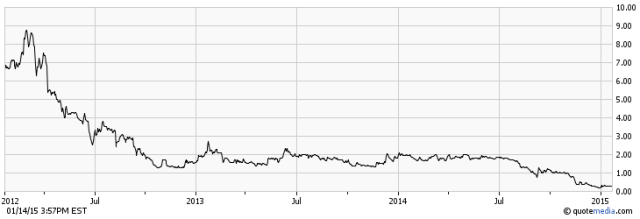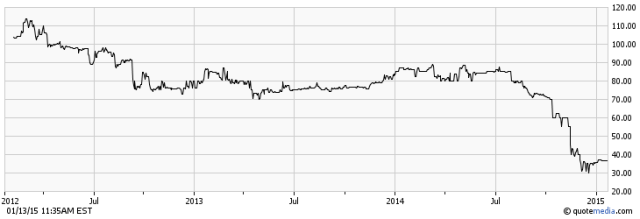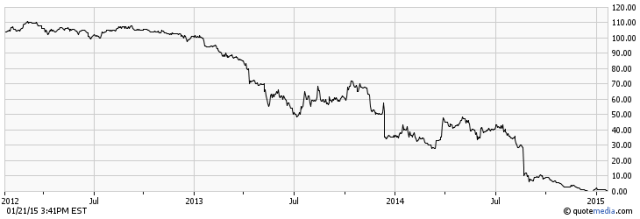I thought Pinetree Capital was going into CCAA, but clearly there was enough arm-wrestling behind closed doors to come to the following agreement (which should hopefully be posted in SEDAR fairly quickly):
In connection with the execution of the Forbearance Agreement, each of Messrs. Roger Rai, Sheldon Inwentash and Marshall Auerback will resign from the board of directors of the company. As well, Mr. Inwentash will resign as Chairman and CEO of the company. Richard Patricio, the company’s Vice-President, Corporate and Legal Affairs will assume the responsibilities of Interim CEO.
Management is gone, plus three (of seven) directors, all of which can be considered to be heavy insiders in the company. Needless to say, considering past performance, this can only be a plus.
The CFO and corporate counsel is still on board, presumably to keep continuity in the overall operation.
I had speculated in my earlier post that the reason why Pinetree did not come to any agreement with debentureholders was because they demanded that management be removed, and it looks like management blinked. The reason for this is perhaps because they did not want to be associated with an entity going into creditor protection. This has to get disclosed in any subsequent documents (such as annual information forms) if management is associated with any publicly traded entities.
the Supporting Debentureholders will have the right to nominate up to three directors to the company’s board of directors; two of whom will constitute an investment oversight committee to be established by the company;
The current board (including the three directors that will be leaving) is of seven people; while this is minority representation, one can presume that they will bring in actual investment expertise to ensure that the interests of the debtholders are respected in future decisions. In particular, the hiring of a new CEO will be the most important decision the reconstituted board will make.
the company will grant security over its assets in favour of all holders of the Debentures;
This will ensure that debenture holders will receive proceeds of any sale of the company, including the value of the deferred tax assets. It will also restrict the company from borrowing more money unless if subsequent lenders understand they are subordinated.
the company will utilize at least $20 million to reduce the aggregate principal amount of the outstanding Debentures by July 31, 2015, and will be subject to a debt-to-assets ratio of 50% (in lieu of 33%) for the three-month period of July through September;
$20 million will be utilized and whatever discount there is to market value will result in a higher par value retired by the corporation. At the current quotation of 70 cents, this would retire about $28 million in par value, or about half the current issue.
the Indenture will be amended to remove restrictions on the company’s redemption rights, subject to the approval of the Toronto Stock Exchange; and
I am not entirely sure what this alludes to, but we will see whenever the agreement is posted on SEDAR.
the trustee and the Debenture holders will refrain from exercising any rights or remedies that they may have against the company under the Indenture or otherwise, as a result of the current default and any subsequent default in respect of the Covenant occurring up to October 31, 2015.
This is functionally a 9 month grace period. The maturity of the debentures is May 2016.
You will have the debtholders working to ensure an efficient liquidation of assets coupled with the possibility that they might end up with a significant equity stake if there is a redemption to equity on the May 2016 maturity. The October 31, 2015 restriction is designed to ensure that debtholders have effective control of the company if Pinetree’s debt-to-asset ratio is not less than 33% by October 31, 2015.
Some remaining questions:
1. Will Pinetree be able to liquidate its holdings efficiently? Reported NAV was 46 cents in November 30, 2014.
2. Final year-end statements must be received and filed publicly by March 31, 2015. At a minimum, it will probably look like their $13 million in deferred tax assets will be vanishing and a valuation allowance put into place. The level 2 and level 3 assets will have to be carefully examined to see if they are worth anything (this was $55 million of the reported $161 million in assets at the Q3-2014 statement).
Finally, the asset remaining on the books that is not going to be seen on the statements will be the half-billion dollar capital loss tax shield. This will get sold, the question is for how much and to who. You would think that the debtholders, compromised mainly of financial firm people, will have a way of getting this into one of their own closed end funds for utilization – funds that generate capital gains to offset such losses.
Currently the equity is getting trashed (at 7 cents per share, down from 11 cents when it was halted), while the debentures are roughly level. My initial suspicion would be that with the removal of management, you would have an increase in valuation, but I guess I was wrong there too.



